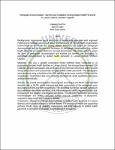| dc.contributor.author | Lokwang, Paul Pax | |
| dc.contributor.author | Udho, Samson | |
| dc.contributor.author | Auma, Anna Grace | |
| dc.date.accessioned | 2023-03-31T07:57:38Z | |
| dc.date.available | 2023-03-31T07:57:38Z | |
| dc.date.issued | 2022 | |
| dc.identifier.citation | Lokwang, P. P., Udho, S., and Auma, A. G. (2022). Partograph Documentation: Barriers and Faciltators Among Skilled Health Personnel in Lamwo District, Northern Uganda | en_US |
| dc.identifier.uri | http://ir.lirauni.ac.ug/xmlui/handle/123456789/548 | |
| dc.description.abstract | Background: Appropriate use of partograph is significantly associated with improved maternal and neonatal outcomes of labour and that is why the World Health Organization recommends its universal use during labour. However, the extent of partograph documentation and the barriers and facilitators to partograph documentation by skilled health personnel in Lamwo district is not well documented. This study aimed to assess the level of partograph documentation and explore the barriers and facilitators to partograph documentation by skilled health personnel in Lamwo district, northern Uganda.
Methods: This was a parallel convergent mixed methods study conducted in 10 purposively sampled health facilities in Lamwo district. We retrospectively reviewed 328 randomly sampled partographs and conducted 18 key informant interviews and 8 Focused Group Discussions with purposively sampled skilled health personnel. The partographs were reviewed using a checklist while FGD and KII guides were used for FGDs and KIIs respectively. Quantitative data were analysed descriptively while qualitative data were analyzed thematically.
Results: The overall documentation of partograph according to the WHO recommended standard was at 54.3% while maternal and fetal components of the partograph were documented at 58% and 95% respectively. The identified barriers to standard partograph documentation were heavy workload, lack of knowledge and skills, negative attitude, lack of equipment and supplies, and negative perception. The identified facilitators were being knowledgeable and skilled, adequate human resource, availability of equipment, supportive supervision, and a positive attitude.
Conclusion: Standard partograph documentation by skilled health personnel in Lamwo district is still suboptimal owed to various factors. The ministry of Health and supporting partners should create an enabling environment and build capacity of skilled health personnel to strengthen Partograph documentation in the district. | en_US |
| dc.language.iso | en | en_US |
| dc.publisher | Lira University | en_US |
| dc.subject | Partograph Documentation: | en_US |
| dc.subject | Barriers and Faciltators | en_US |
| dc.subject | Skilled Health Personnel | en_US |
| dc.subject | Lamwo District | en_US |
| dc.subject | Northern Uganda | en_US |
| dc.title | Partograph Documentation: Barriers and Faciltators Among Skilled Health Personnel in Lamwo District, Northern Uganda | en_US |
| dc.type | Thesis | en_US |

